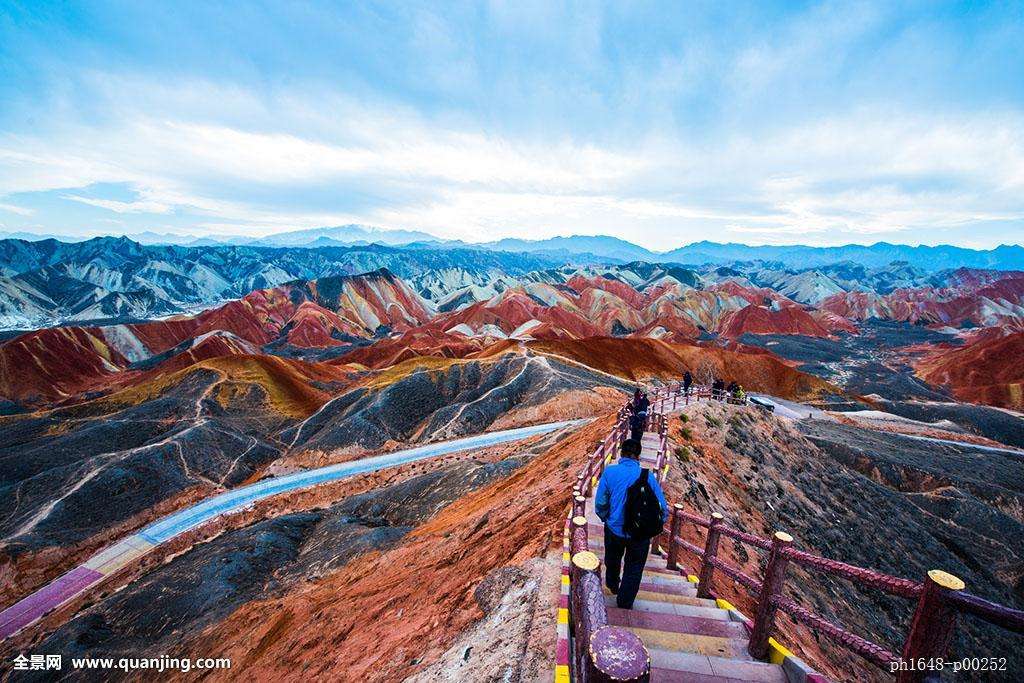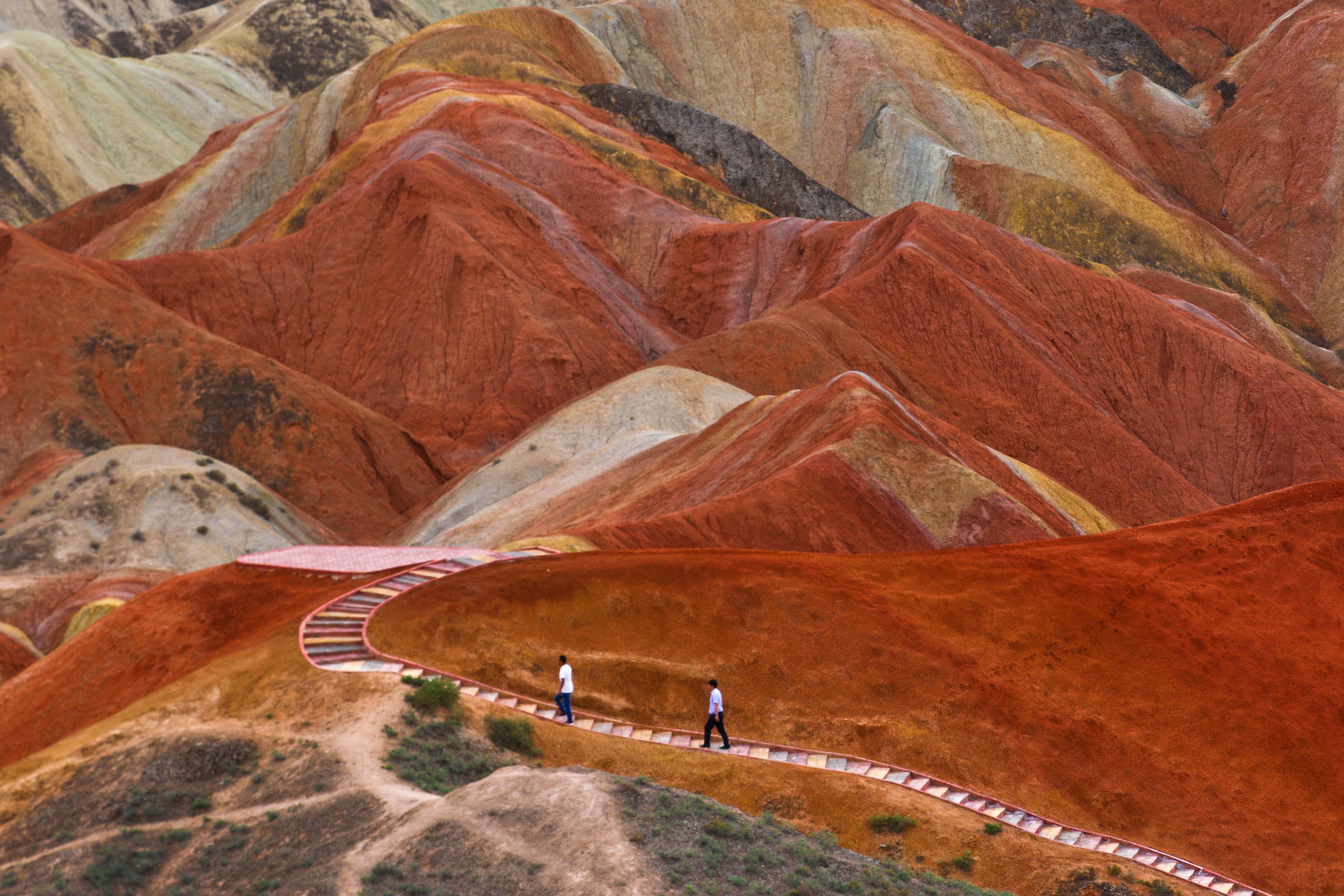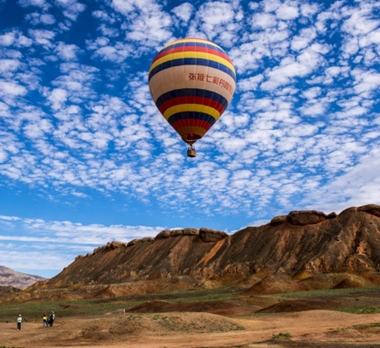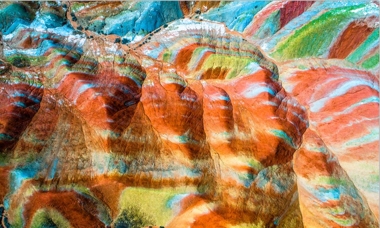Home > Attractions >
Zhangye Danxia Landform
Sitting on the edge of the Silk Road ( 丝绸之路 ), Zhangye Danxia National Geological Park ( Chinese name: 张掖丹霞国家地质公园 ) is located in northwest China's Gansu Province. It is a spectacular multicolor covering a large area of the cliffs that have made the place look like a masterpiece of an oil painting against the canvas of surrounding grey plain. The landform is the result of red sandstone erosion, together with its geological structure and long term desert conditions, wind and water erosion. The great force of nature has its great artwork emerged.
The ferruginous rocks are red, the argillaceous stones are grey, the phosphatic rocks are greyish-blue, the volcanic rocks are orange-yellow, and the pebbly rocks are cyan. All of the colors are intertwined in these magnificent rainbow hills.
The geopark is divided into two distinctive areas: Colorful Hills, featuring the bright and contrasting colors, and Ice Valley, famous for its bizarre forms.
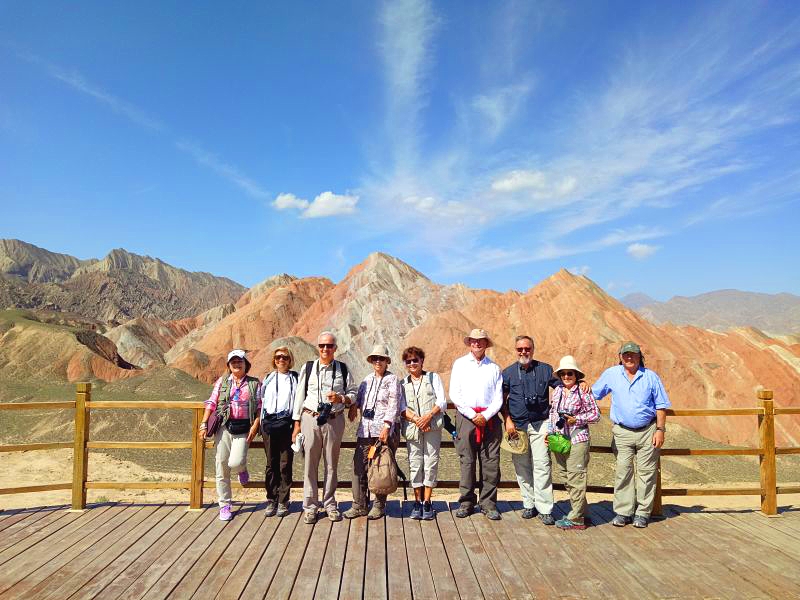
The first viewing platform is the largest platform and the nearest to the entrance, at 10 minutes' walk away. You don't need to walk up many steps to get to the viewing platform. It's practically at ground level, and you can see the high, colorful mountains.
Use your imagination, and you will see shapes in the mountains known as Monks Worshiping the Buddha, the vast "scallops," Monkeys Rush into the Sea of Fire, and Rainbow Hill.
Second Viewing Platform: There are two platforms at this point - one at the base and one at the top of a hill. You only need to walk for a few minutes to get to the base platform, but it takes a lot of effort to get to the top. At the base platform, you can see a mountain shaped like a sleeping beauty.
The top platform is the highest viewing platform. It has 666 steps, which take about 30 minutes to climb. The wooden path to the top platform is like the Great Wall winding along the ridge. At the top, you can take a photo of the panoramic view. It's also an excellent place to enjoy the sunset.

Third Viewing Platform: The third viewing platform allows a view of the famous 'Seven-Color Fan.' The mountain looks like it has painted with a colorful palette. The enormous rolling hills look very soothing with their pastel colors.
Fourth Viewing Platform: The fourth viewing platform has the most stunning view. It is on a ridge that runs from east to west. Standing on the hill and looking south, you can feast your eyes on the variegated colors of Qicai Shan (Seven-Color Mountain).
It is best to visit in the morning and at dusk, especially at sunset, when the colors change continuously, showing yellow and red layers covered by a light grey layer.
Approximate sunset time: 7:30 pm in spring and autumn; 8:00 pm in summer
a) Arrive at Zhangye Danxia By Air:
There are direct flights from Lanzhou, Xi'an, Urumqi, and Dunhuang to Zhangye Ganzhou Airport ( the airfare is from 300 -1000 CNY/pp include tax)
Zhangye Ganzhou Airport ( 张掖甘州机场 in Chinese ) is about 63km away from Danxia National Geopark, which takes 1 hour and 10 minutes to drive.
Zhangye Ganzhou Airport is a dual-use military and civil airport serving the city of Zhangye in Gansu Province, China. It is located 24 kilometers from the city center. Construction began in May 2010 to convert the airbase to a dual-use airport. The airport was opened on 1 November 2011.
b) Arrive at Zhangye Danxia By Train:
Zhangye West Railway Station, located in Zhangye City, Gansu Province, China. It operates the high-speed trains to/from Xi'an, Lanzhou, Urumqi, Jiayuguan.
Zhangye West Railway Station is about 3 km from the city center, about 40 km from Zhangye Danxia National Geological Park.
The train far from Lanzhou to Zhangye is 200-300 CNY/pp include tax.
c) Arrive at Zhangye Danxia By Bus:
Take the bus from Zhangye to Sunan County or Linze County at Zhangye West bus station. There is a shuttle bus from Zhangye West bus station to Danxia Park, and you can get off at the gate of the scenic spot. The fare is CNY 10 / pp.
The operation shift is 9:00-12:00 every hour, 15:30-16:30 each time.
l The park is far away from the city; travellers should bring some food and drinks.
l The sights are widely distributed. The tour route is very long with no walkways. Visitors need to take the sightseeing bus.
l The scenery is situated in arid and barren areas; tourists should take sunscreen products.
Related Articles & Posts
 Giant Buddha Temple
Giant Buddha Temple 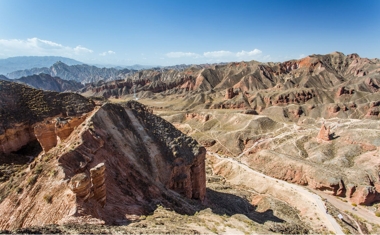 Binggou Danxia Landform
Binggou Danxia Landform
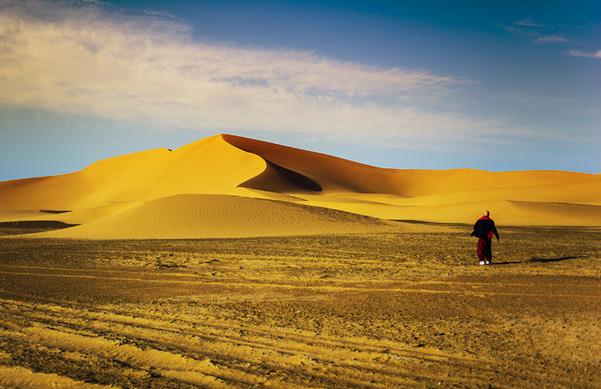 Badanjaran Desert
Badanjaran Desert 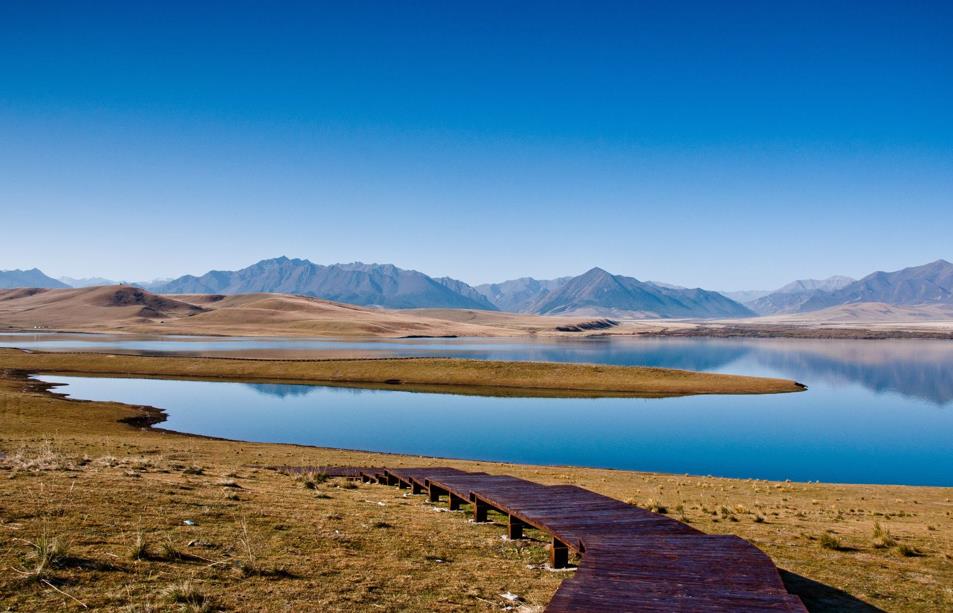 Shandanjun Horse Farm
Shandanjun Horse Farm
Recommended Gansu Tours
 Danxia Rainbow Mountain Photography Tour
Danxia Rainbow Mountain Photography Tour 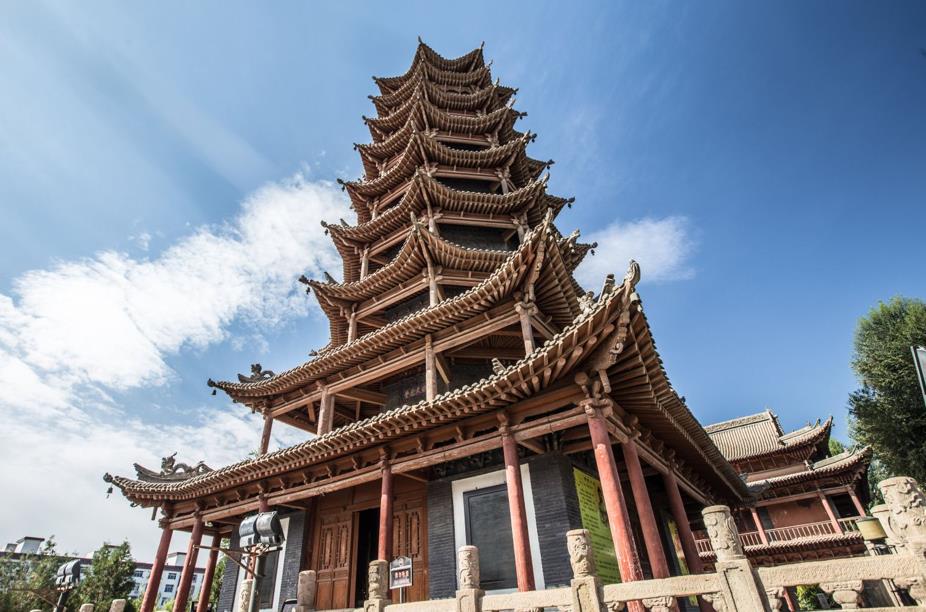 Zhangye-Jiayuguan Pass-Dunhuang Tour
Zhangye-Jiayuguan Pass-Dunhuang Tour
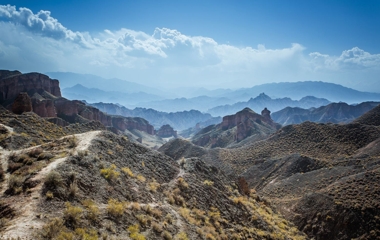 Silk Road and Hexi Corridor Adventure
Silk Road and Hexi Corridor Adventure  Silk Road Travel to Qinghai-Gansu and Xinjiang
Silk Road Travel to Qinghai-Gansu and Xinjiang
Zhangye Overview:
Zhangye ( 张掖 in Chinese ), located in the northwest of Gansu Province in China, it was called "Ganzhou" in ancient times. In Chines history, Zhangye City is part of the Hexi Corridor, which is an essential route for connecting China to the Western world in Gansu Province via the Silk Road.How was the Danxia Landform in the Geopark Formed?
Zhangye Danxia landform's geomorphic development happened in about Jurassic period. It is a result of red sandstone erosion, together with its geological structure and long-term desert conditions, wind and water erosion. During the mid-Cretaceous age, iron and other elements contained in the sediment started to exchange and oxidize, which formed different layers of colors in different strata.The ferruginous rocks are red, the argillaceous stones are grey, the phosphatic rocks are greyish-blue, the volcanic rocks are orange-yellow, and the pebbly rocks are cyan. All of the colors are intertwined in these magnificent rainbow hills.
The geopark is divided into two distinctive areas: Colorful Hills, featuring the bright and contrasting colors, and Ice Valley, famous for its bizarre forms.

Viewing Platforms in Danxia National Geological Park
Zhangye Rainbow Danxia Landform has four viewing platforms for visitors to admire the splendid scenes and take pictures. The sightseeing bus can take you to each of them, and travelers can also walk to every platform.The first viewing platform is the largest platform and the nearest to the entrance, at 10 minutes' walk away. You don't need to walk up many steps to get to the viewing platform. It's practically at ground level, and you can see the high, colorful mountains.
Use your imagination, and you will see shapes in the mountains known as Monks Worshiping the Buddha, the vast "scallops," Monkeys Rush into the Sea of Fire, and Rainbow Hill.
Second Viewing Platform: There are two platforms at this point - one at the base and one at the top of a hill. You only need to walk for a few minutes to get to the base platform, but it takes a lot of effort to get to the top. At the base platform, you can see a mountain shaped like a sleeping beauty.
The top platform is the highest viewing platform. It has 666 steps, which take about 30 minutes to climb. The wooden path to the top platform is like the Great Wall winding along the ridge. At the top, you can take a photo of the panoramic view. It's also an excellent place to enjoy the sunset.

Third Viewing Platform: The third viewing platform allows a view of the famous 'Seven-Color Fan.' The mountain looks like it has painted with a colorful palette. The enormous rolling hills look very soothing with their pastel colors.
Fourth Viewing Platform: The fourth viewing platform has the most stunning view. It is on a ridge that runs from east to west. Standing on the hill and looking south, you can feast your eyes on the variegated colors of Qicai Shan (Seven-Color Mountain).
Opening Hours & Admission Fee
| Opening Hours |
Peak season: 1st May to 10th October ( 6:00 - 20:00 ) Off-season: 11th October to 30th April Next Year ( 7:00 - 19:00 ) |
| Admission Fee | 75 CNY ( Including Shuttle Bus ) |
| Hot-air Balloon |
Adults: CNY 200/pp, Children: Under 1.4m: CNY 150 / pp Note: The hot-air balloons can take 5 - 6 person, with a duration of 6 - 10 minutes, which depends on the weather conditions. It will take longer if the weather is good. |
Climate and Weather of Zhangye:
Zhangye is a typical temperate continental arid climate, with long sunshine time, sufficient light and heat resources, cold winter and warm summer, four distinct seasons plus little precipitation, and the average temperature is about seven degrees Celsius. The monthly 24-hour average temperature ranges from −9.2 °C in January to 21.5 °C in July. The mean annual temperature is 7.31 °C, while annual rainfall is 130 mm, almost all of which falls from May to September. In winter are dry and cold. June to September is the best time to travel to Zhangye, because, at this time the rainfall is relatively concentrated and the humid air will make people feel more comfortable.Annual Temperature of the Year/℃ ( High-Low )
| Jan. | Feb. | Mar. | Apr. | May. | Jun. |
| -2/-15 | -2/-10 | 15/-2 | 15/1 | 25/19 | 28/14 |
| July | Aug. | Sept. | Oct. | Nov. | Dec. |
| 31/17 | 30/15 | 22/5 | 15/0 | 6/-10 | 3/-16 |
When is the best time to visit Danxia National Geopark?
Marco Polo once said: This region was an international trade market. Nowadays, it has turned into a tourism city that attracts many people. Every June and July are the best time to visit Zhangye National Geopark. During the rainy season, the water can cool you from the summer heat and add moisture to the air.It is best to visit in the morning and at dusk, especially at sunset, when the colors change continuously, showing yellow and red layers covered by a light grey layer.
Approximate sunset time: 7:30 pm in spring and autumn; 8:00 pm in summer
The Best Shooting Time in Danxia National Geopark:
Zhangye Danxia Landform is a paradise for photography lovers. After the rain, the color of the Danxia becomes more intense. The best shooting time is in the afternoon when Danxia has the most sense of hierarchy. There are many viewing platforms in the scenic area, while the No. 4 viewing platform is the best one for shooting sunset and sunrise, and the No. 2 viewing platform is the best one for shooting a panorama.How to Get to Danxia National Geological Park:
There are three ways to get to the Danxia geopark: Flight, Train, and Busa) Arrive at Zhangye Danxia By Air:
There are direct flights from Lanzhou, Xi'an, Urumqi, and Dunhuang to Zhangye Ganzhou Airport ( the airfare is from 300 -1000 CNY/pp include tax)
Zhangye Ganzhou Airport ( 张掖甘州机场 in Chinese ) is about 63km away from Danxia National Geopark, which takes 1 hour and 10 minutes to drive.
Zhangye Ganzhou Airport is a dual-use military and civil airport serving the city of Zhangye in Gansu Province, China. It is located 24 kilometers from the city center. Construction began in May 2010 to convert the airbase to a dual-use airport. The airport was opened on 1 November 2011.
b) Arrive at Zhangye Danxia By Train:
Zhangye West Railway Station, located in Zhangye City, Gansu Province, China. It operates the high-speed trains to/from Xi'an, Lanzhou, Urumqi, Jiayuguan.
Zhangye West Railway Station is about 3 km from the city center, about 40 km from Zhangye Danxia National Geological Park.
The train far from Lanzhou to Zhangye is 200-300 CNY/pp include tax.
c) Arrive at Zhangye Danxia By Bus:
Take the bus from Zhangye to Sunan County or Linze County at Zhangye West bus station. There is a shuttle bus from Zhangye West bus station to Danxia Park, and you can get off at the gate of the scenic spot. The fare is CNY 10 / pp.
The operation shift is 9:00-12:00 every hour, 15:30-16:30 each time.
Zhangye Danxia Tips:
l On cloudy days, the scenery of Danxia is not as bright as that of the propaganda photos, so the tourists should have a mental preparation.l The park is far away from the city; travellers should bring some food and drinks.
l The sights are widely distributed. The tour route is very long with no walkways. Visitors need to take the sightseeing bus.
l The scenery is situated in arid and barren areas; tourists should take sunscreen products.
Related Articles & Posts
 Giant Buddha Temple
Giant Buddha Temple  Binggou Danxia Landform
Binggou Danxia Landform  Badanjaran Desert
Badanjaran Desert  Shandanjun Horse Farm
Shandanjun Horse Farm Recommended Gansu Tours
 Danxia Rainbow Mountain Photography Tour
Danxia Rainbow Mountain Photography Tour  Zhangye-Jiayuguan Pass-Dunhuang Tour
Zhangye-Jiayuguan Pass-Dunhuang Tour  Silk Road and Hexi Corridor Adventure
Silk Road and Hexi Corridor Adventure  Silk Road Travel to Qinghai-Gansu and Xinjiang
Silk Road Travel to Qinghai-Gansu and Xinjiang 
